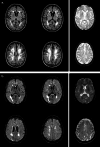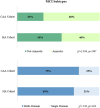Cognitive profile in cerebral small vessel disease: comparison between cerebral amyloid angiopathy and hypertension-related microangiopathy
- PMID: 38467658
- PMCID: PMC10928167
- DOI: 10.1038/s41598-024-55719-w
Cognitive profile in cerebral small vessel disease: comparison between cerebral amyloid angiopathy and hypertension-related microangiopathy
Erratum in
-
Author Correction: Cognitive profile in cerebral small vessel disease: comparison between cerebral amyloid angiopathy and hypertension-related microangiopathy.Sci Rep. 2024 Apr 16;14(1):8792. doi: 10.1038/s41598-024-59216-y. Sci Rep. 2024. PMID: 38627411 Free PMC article. No abstract available.
Abstract
Cerebral amyloid angiopathy (CAA) is recognized as a cause of cognitive impairment, but its cognitive profile needs to be characterized, also respect to hypertension-related microangiopathy (HA). We aimed at comparing difference or similarity of CAA and HA patients' cognitive profiles, and their associated factors. Participants underwent an extensive clinical, neuropsychological, and neuroimaging protocol. HA patients (n = 39) were more frequently males, with history of vascular risk factors than CAA (n = 32). Compared to HA, CAA patients presented worse performance at MoCA (p = 0.001) and semantic fluency (p = 0.043), and a higher prevalence of amnestic MCI (46% vs. 68%). In univariate analyses, multi-domain MCI was associated with worse performance at MoCA, Rey Auditory Verbal Learning Test (RAVLT), and semantic fluency in CAA patients, and with worse performance at Symbol Digit Modalities Test (SDMT) and phonemic fluency in HA ones. In multivariate models, multi-domain deficit remained as the only factor associated with RAVLT (β = - 0.574) in CAA, while with SDMT (β = - 0.364) and phonemic fluency (β = - 0.351) in HA. Our results highlight different patterns of cognitive deficits in CAA or HA patients. While HA patients' cognitive profile was confirmed as mainly attentional/executive, a complex cognitive profile, characterized also by deficit in semantic memory, seems the hallmark of CAA patients.
Keywords: Arteriolosclerosis; Cerebral amyloid angiopathy; Cerebral small vessel disease; Cognition; Cognitive decline; Cognitive impairment; Cognitive profile; Microangiopathy; Neuropsychological patterns.
© 2024. The Author(s).
Conflict of interest statement
The authors declare no competing interests.
Figures




Similar articles
-
Cognitive Profile and its Association with Neuroimaging Markers of Non-Demented Cerebral Amyloid Angiopathy Patients in a Stroke Unit.J Alzheimers Dis. 2016 Mar 8;52(1):171-8. doi: 10.3233/JAD-150890. J Alzheimers Dis. 2016. PMID: 27060947
-
Comorbid cerebral amyloid angiopathy in dementia and prodromal stages-Prevalence and effects on cognition.Int J Geriatr Psychiatry. 2023 Oct;38(10):e6015. doi: 10.1002/gps.6015. Int J Geriatr Psychiatry. 2023. PMID: 37847104
-
Cerebral Amyloid Angiopathy Is Associated With Executive Dysfunction and Mild Cognitive Impairment.Stroke. 2016 Aug;47(8):2010-6. doi: 10.1161/STROKEAHA.116.012999. Epub 2016 Jun 23. Stroke. 2016. PMID: 27338926
-
Cerebral amyloid angiopathy-related cognitive impairment: The search for a specific neuropsychological pattern.Rev Neurol (Paris). 2017 Nov;173(9):562-565. doi: 10.1016/j.neurol.2017.09.006. Epub 2017 Oct 6. Rev Neurol (Paris). 2017. PMID: 28993004 Review.
-
[Current findings on the coincidence of cerebral amyloid angiopathy and Alzheimer's disease].Nervenarzt. 2022 Jun;93(6):605-611. doi: 10.1007/s00115-021-01213-x. Epub 2021 Oct 15. Nervenarzt. 2022. PMID: 34652483 Free PMC article. Review. German.
Cited by
-
Additive effects of cerebrovascular disease functional connectome phenotype and plasma p-tau181 on longitudinal neurodegeneration and cognitive outcomes.Alzheimers Dement. 2024 Dec;20(12):8739-8757. doi: 10.1002/alz.14328. Epub 2024 Nov 13. Alzheimers Dement. 2024. PMID: 39537356 Free PMC article.
-
Non-classical monocyte levels correlate negatively with HIV-associated cerebral small vessel disease and cognitive performance.Front Cell Infect Microbiol. 2024 Oct 23;14:1405431. doi: 10.3389/fcimb.2024.1405431. eCollection 2024. Front Cell Infect Microbiol. 2024. PMID: 39507948 Free PMC article.

